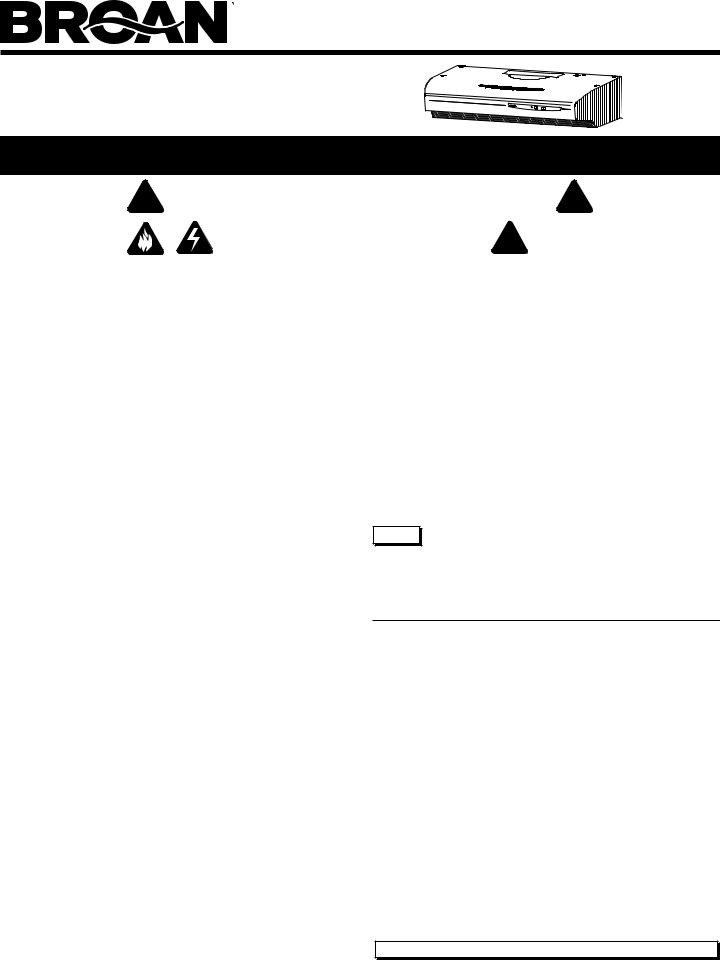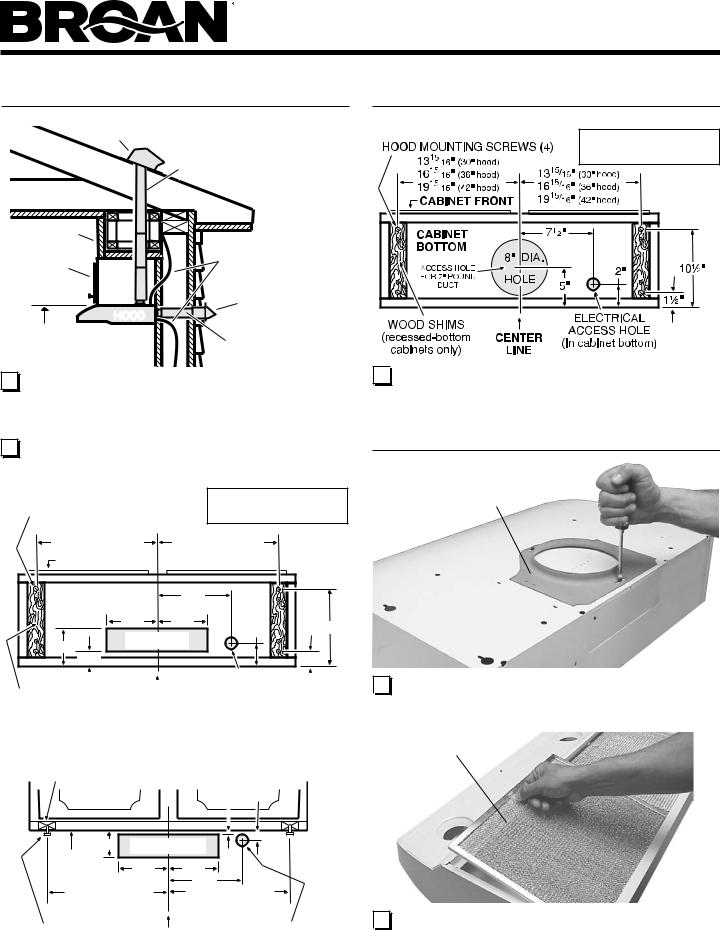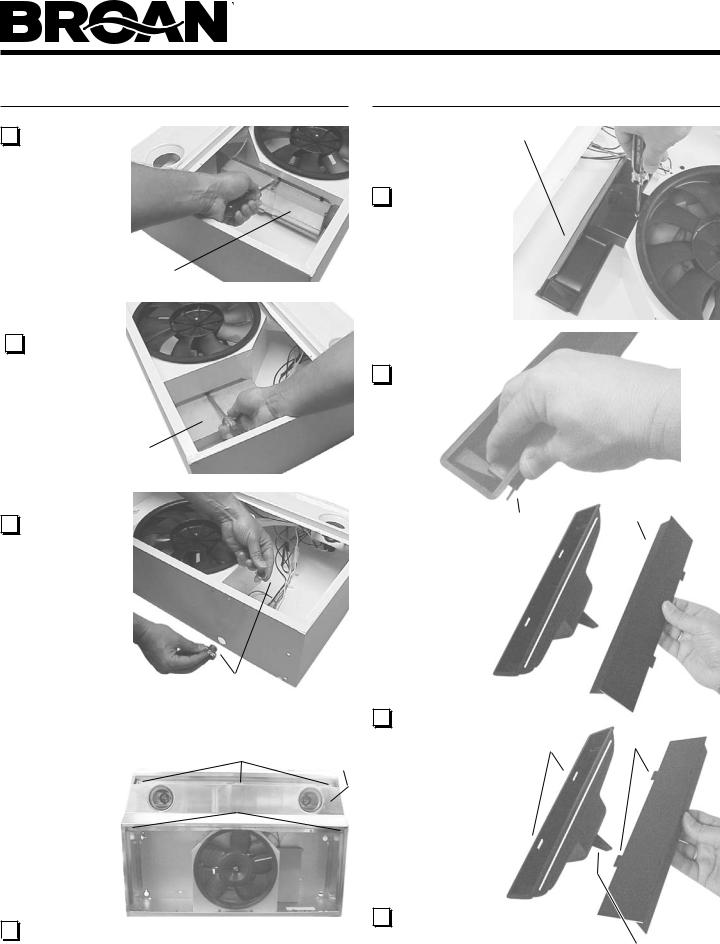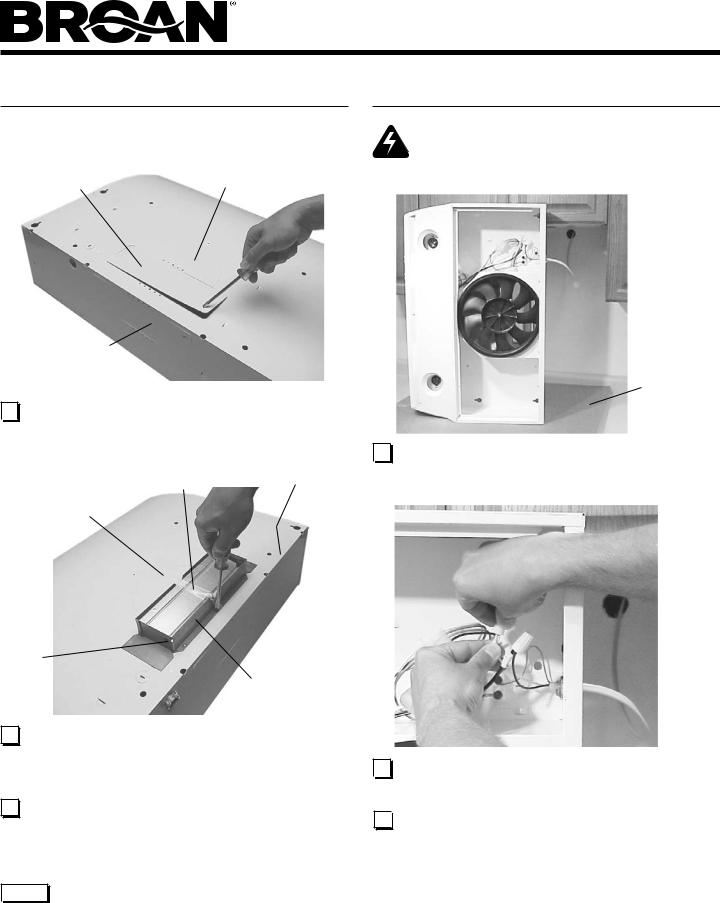Broan QS130BL, QS136BC, QS136BL, QS136WW User Manual

|
ALLURE™ QS1 SERIES |
|
ALLURE™ |
RANGE HOOD |
|
Page 1 |
||
QS1 SERIES RANGE HOODS |
||
US D450, 829 S |
||
|
Patent No.: |
READ AND SAVE THESE INSTRUCTIONS
! |
FOR DOMESTIC COOKING ONLY. ! |
||
WARNING |
|
|
CAUTION ! |
TO REDUCE THE RISK OF FIRE, ELECTRIC SHOCK, OR INJURY TO PERSONS, OBSERVE THE FOLLOWING:
1.Use this unit only in the manner intended by the manufacturer. If you have questions, contact the manufacturer at the address or telephone number listed in the warranty.
2.Before servicing or cleaning unit, switch power off at service panel and lock the service disconnecting means to prevent power from being switched on accidentally. When the service disconnecting means cannot be locked, securely fasten a prominent warning device, such as a tag, to the service panel.
3.Installation work and electrical wiring must be done by a qualified person(s) in accordance with all applicable codes and standards, including fire-rated construction codes and standards.
4.Sufficient air is needed for proper combustion and exhausting of gases through the flue (chimney) of fuel burning equipment to prevent backdrafting. Follow the heating equipment manufacturer’s guideline and safety standards such as those published by the National Fire Protection Association (NFPA), and the American Society of Heating, Refrigeration and Air Conditioning Engineers (ASHRAE), and the local code authorities.
5.When cutting or drilling into wall or ceiling, do not damage electrical wiring and other hidden utilities.
6.To reduce the risk of fire or electric shock, do not use this range hood with an additional speed control device.
7.Ducted fans must always be vented to the outdoors.
8.To reduce the risk of fire, use only metal ductwork.
9.Use with approved cord-connection kit only.
10.This unit must be grounded.
TO REDUCE THE RISK OF A RANGE TOP GREASE FIRE:
1.Never leave surface units unattended at high settings. Boilovers cause smoking and greasy spillovers that may ignite. Heat oils slowly on low or medium settings.
2.Always turn hood ON when cooking at high heat or when cooking flaming foods.
3.Clean ventilating fans frequently. Grease should not be allowed to accumulate on fan or filter.
4.Use proper pan size.Always use cookware appropriate for the size of the surface element.
TO REDUCE THE RISK OF INJURY TO PERSONS IN THE EVENT OF A RANGE TOP GREASE FIRE, OBSERVE THE FOLLOWING:*
1.SMOTHER FLAMES with a close-fitting lid, cookie sheet, or metal tray, then turn off the burner. BE CAREFUL TO PREVENT BURNS. If the flames do not go out immediately, EVACUATE AND CALL THE FIRE DEPARTMENT.
2.NEVER PICK UP A FLAMING PAN — You may be burned.
3.DO NOT USE WATER, including wet dishcloths or towels - violent steam explosion will result.
4.Use an extinguisher ONLY if:
A.You know you have a Class ABC extinguisher and you already know how to operate it.
B.The fire is small and contained in the area where it started.
C.The fire department is being called.
D.You can fight the fire with your back to an exit.
*Based on “Kitchen Fire Safety Tips” published by NFPA.
1.For indoor use only.
2.For general ventilating use only. Do not use to exhaust hazardous or explosive materials and vapors.
3.To avoid motor bearing damage and noisy and/or unbalanced impellers, keep drywall spray, construction dust, etc. off power unit.
4.For best capture of cooking impurities, your range hood should be mounted so that the top of the hood is 24-30” above the cooking surface.
5.Please read specification label on product for further information and requirements.
Installer: Leave this manual with the homeowner.
Homeowner: Operating and Cleaning information on page 5.
NOTE |
If hood is to be installed Non-Ducted: |
|
Purchase a set of (2) non-ducted filters from your |
|
local distributor or retailer and attach them to the |
|
aluminum mesh filters. |
TABLE OF CONTENTS
This manual is divided into sections as follows:
“PREPARE HOOD LOCATION”
Run ductwork from roof or wall cap, and electrical wiring from service panel - to installation location
“PREPARE THE HOOD”
Get your hood ready for installation
“CONNECT WIRING”
Make electrical wiring connections to hood
“INSTALL HOOD”
Secure hood to cabinet and ductwork - install bulbs and filters
“OPERATION”
How to use the hood controls
“CLEANING”
Keep your hood in top working condition
“SERVICE PARTS”
Part numbers and exploded view of hood components
“WARRANTY”
One-year limited warranty and how to contact us
Register your product online at: www.broan.com/register

ALLURE™ QS1 SERIES RANGE HOOD
PREPARE HOOD LOCATION
ROOF CAP |
|
3¼” X 10” or |
|
|||
|
|
|
7” |
3¼" X 10" |
|
|
|
|
|
ROUND DUCT |
|
||
|
|
|
|
(For vertical |
|
|
|
|
|
|
discharge)) |
|
|
|
|
|
|
|
|
|
|
|
|
|
|
|
|
|
|
|
|
|
|
|
SOFFIT |
|
|
|
HOUSE WIRING |
|
CABINET |
(Top or Back of hood) |
|
|
WALL CAP |
|
HOOD |
|
|
24" - 30" ABOVE |
3¼" X 10" DUCT |
|
COOKING SURFACE |
||
(For horizontal discharge) |
||
|
||
1 Determine whether hood will discharge vertically (3¼” x 10” |
||
or 7” Round), horizontally (3¼” x 10” only) or non-ducted. For |
||
vertical or horizontal discharge, run ductwork between the |
||
hood location and a roof cap or wall cap. For best results, use |
||
a minimum number of transitons and elbows. |
||
2 Use diagrams, below, for proper placement of ductwork and |
||
electrical cutout in cabinet or wall. For a non-ducted installa- |
||
tion, DO NOT cut a duct access hole. |
||
HOOD MOUNTING SCREWS (4) |
3¼” X 10” |
||||
VERTICAL DUCTING |
|||||
1315/16" (30" hood) |
|
||||
1315/16" (30" hood) |
|
||||
1615/16" (36" hood) |
|
||||
1915/16" (42" hood) |
1615/16" (36" hood) |
|
|||
CABINET FRONT |
1915/16" (42" hood) |
|
|||
|
|
7½" |
|
|
|
|
CABINET BOTTOM |
|
|
||
|
5¼" |
5¼" |
2" |
10½" |
|
|
VERTICAL DUCT |
||||
|
|
||||
|
|
|
|||
5" |
ACCESS HOLE |
|
|
||
1¼" |
|
|
1½" |
||
|
|
|
|||
|
|
|
|
ELECTRICAL |
|
|
||||
|
|
|
|
|
||||||
WOOD SHIMS |
|
|
ACCESS HOLE |
|||||||
CENTER |
||||||||||
(recessed-bottom |
(in cabinet bottom) |
|||||||||
LINE |
||||||||||
cabinets only) |
|
|
|
|
|
|
||||
|
|
|
|
|
|
|
|
|||
|
|
|
|
|
||||||
WOOD SHIMS |
|
|
|
3¼” X 10” |
||||||
(recessed-bottom |
|
|
HORIZONTAL DUCTING |
|||||||
cabinets only) |
|
|
||||||||
CABINET FRONT |
||||||||||
|
|
|
|
1/8" ¾" |
|
|
|
|
||
|
|
|
|
|
|
|
|
|
|
|
|
|
|
|
|
|
|
|
|
|
|
|
|
|
|
|
|
|
|
|
|
|
3¾" |
HORIZONTAL DUCT |
|
||
ACCESS HOLE |
|
|||
CABINET |
|
|||
5¼" |
5¼" |
|
||
BOTTOM |
|
|||
1315/16" (30" hood) |
7½" |
|
||
1315/16" (30" hood) |
||||
1615/16" (36" hood) |
||||
1615/16" (36" hood) |
||||
1915/16" (42" hood) |
||||
1915/16" (42" hood) |
||||
HOOD |
|
|||
|
|
ELECTRICAL |
||
MOUNTING |
CENTER |
|||
ACCESS HOLE |
||||
SCREWS (4) |
LINE |
|
||
|
(in wall) |
|||
|
|
|||
|
|
|
||
Page 2
PREPARE HOOD LOCATION
7” ROUND
VERTICAL DUCTING
3  Run house wiring between service panel and hood location.
Run house wiring between service panel and hood location.
PREPARE THE HOOD
7” ROUND DUCT PLATE
1 Remove 7” Round Duct Plate from top of hood. Set duct  plate aside - with mounting screws.
plate aside - with mounting screws.
FILTERS 
2 Remove tape holding Filters in place. Pull down on filter  tabs and lift filters out. Set filters aside.
tabs and lift filters out. Set filters aside.

ALLURE™ QS1 SERIES RANGE HOOD
PREPARE THE HOOD
3 Remove
Damper/Duct Connector from inside the hood. Set connec-
tor aside - with mounting screws and parts bag.
DAMPER/DUCT
CONNECTOR
4 |
Remove Wir- |
|
ing Cover from |
|
inside the hood. |
|
Set cover and |
|
mounting screw |
|
aside. |
WIRING
COVER
5 |
Remove either |
|
top or back wir- |
|
ing knockout and |
|
install approved |
|
Electrical Cable |
|
Clamp. |
Page 3
PREPARE THE HOOD
AIR CHUTE
7 |
Remove Air |
|
Chute - held in |
|
place with one |
|
(1) screw. |
NOTE: Be careful not to disconnect any wires.
8 |
Remove Baffle |
|
from air chute. |
|
BAFFLE |
BAFFLE |
|
|
|
ELECTRICAL CABLE CLAMP
Non-Ducted Installation - Skip to “Connect |
||
Wiring” section. |
(3) #8 SCREWS |
LIGHT |
|
||
|
PANEL |
|
The following |
|
|
|
|
|
Steps (6 thru |
(2) #8 SCREWS |
|
13) are for |
|
|
|
|
|
DUCTED |
|
|
INSTALLATION |
|
|
ONLY. |
|
|
6 Remove Light Panel - held in place with (3) #8 screws  and (2) #8 screws. Disconnect light assembly wire harness
and (2) #8 screws. Disconnect light assembly wire harness
(white connector).
9 Rotate baffle. Re- |
|
|
insert baffle into air |
|
TABS |
chute (as shown) so |
SLOTS |
|
that baffle tabs fit all |
|
|
the way into slots in |
|
|
air chute. An audible |
|
|
“click” will be heard |
|
|
when fully installed. |
|
|
This will close off |
|
|
the air flow through |
|
|
the non-ducted slots |
|
|
on top of hood. |
|
|
|
|
|
10 Re-install air chute, re-connect wire |
|
|
harness, and replace light panel. |
|
|
NOTE: Be careful not to trap wires |
SUPPORT FIN |
|
between support fin and light panel. |
||
|

ALLURE™ QS1 SERIES RANGE HOOD
PREPARE THE HOOD
TOP RECTANGULAR |
|
|
DUCT KNOCKOUT |
SEMI-CIRCULAR |
|
(Remove for 3¼” x 10” |
||
DUCT KNOCKOUT |
||
Vertical & for 7” Round |
||
(Remove for 7” Round |
||
Discharge) |
||
Discharge) |
||
|
REAR
RECTANGULAR DUCT KNOCKOUT
(Remove for 3¼” x 10” Horizontal Discharge)
11 Remove appropriate Duct Knockout(s) from top or back of  hood.
hood.
UP TO 1” |
|
TAPE |
TOP/BACK |
|
EDGE |
||
SIDE-TO-SIDE |
|
|
|
ADJUSTMENT |
|
|
|
|
Ú |
|
|
|
|
|
PIVOT |
DAMPER/DUCT |
|
|
|
CONNECTOR |
|
(Vertical discharge |
|
position shown) |
12 |
3¼” x 10” Ducted Discharge Only: Attach Damper/Duct |
|
Connector over knockout opening. Make sure damper Pivot |
|
is nearest to Top/Back Edge of hood. Remove Tape from |
|
damper flap. |
13 |
7” Round Ducted Discharge Only: Re-install 7” Round Duct |
|
Plate removed in Step #1 under “PREPARE THE HOOD” |
|
section. Install a 7” round damper (purchase separately). |
|
Damper flap must open freely in direction of air flow (away |
|
from range hood). |
NOTE To accomodate off-center ductwork, the Damper/Duct  Connector can be installed up to 1-inch on either side of hood center or the 7” Round Duct Plate can be installed up to ½” on either side of hood center. In extreme off-center
Connector can be installed up to 1-inch on either side of hood center or the 7” Round Duct Plate can be installed up to ½” on either side of hood center. In extreme off-center
installations, one end of the duct connector may need to be trimmed to clear the electrical cable clamp.
Page 4
CONNECT WIRING
 WARNING: To reduce the risk of electric shock, make sure power is switched off at the service
WARNING: To reduce the risk of electric shock, make sure power is switched off at the service 
 panel. Lock or tag service panel to prevent power
panel. Lock or tag service panel to prevent power
from being switched on accidentally.
 HOUSE WIRING
HOUSE WIRING
(120 VAC)
CARDBOARD
(Use to protect cooktop)
1 Connect House Wiring (120 VAC) to hood. Use a piece of  Cardboard to protect the cooktop, if necessary.
Cardboard to protect the cooktop, if necessary.
GREEN
GROUND
 SCREW
SCREW
2 Connect house black to hood black wire, house white to hood  white wire, and house ground under Green Ground Screw.
white wire, and house ground under Green Ground Screw.
Securely tighten cable clamp onto house wiring.
3  Replace wiring cover.
Replace wiring cover.
